Search the Special Collections and Archives Portal
Search Results
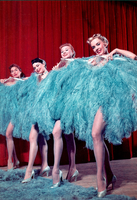
Photograph of the Copa Girls posing with blue ostrich feather fans, Las Vegas, circa 1955
Date
1954 to 1956
Archival Collection
Description
Four Copa Girls pose onstage with oversized blue ostrich feather fans; they stand in front of a red curtain.
Show Name: Fan Dance
Site Name: Sands Hotel and Casino
Show Name: Fan Dance
Site Name: Sands Hotel and Casino
Image
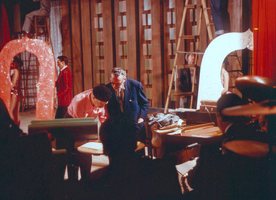
Photograph of dress rehearsal in Sands Hotel showroom, Las Vegas, circa 1950s
Date
1950 to 1959
Archival Collection
Description
Musicians, crew members and Copa Girls onstage during dress rehearsal for "Where's Ace?" number at the Sands Hotel.
Show Name: Where's Ace?
Site Name: Sands Hotel and Casino
Show Name: Where's Ace?
Site Name: Sands Hotel and Casino
Image
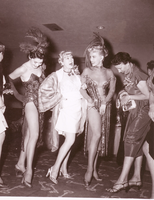
Photograph of former Ziegfeld Girls visiting with the Copa Girls, Las Vegas, 1954
Date
1954
Archival Collection
Description
Former Ziegfeld Girl Gladys Gardner (in white dress) and another former Ziegfeld Girl (at right) visit with some of the Copa Girls at the Sands Hotel.
Show Name: Ziegfeld Follies
Site Name: Sands Hotel and Casino
Image
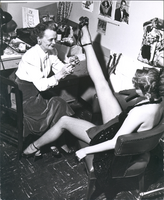
Photograph of Madame Pauline with a Copa Girl, Las Vegas, 1954
Date
1954
Archival Collection
Description
Wardrobe mistress Pauline with a Copa Girl in a dressing room at the Sands Hotel.
Show Name: Ziegfeld Follies
Site Name: Sands Hotel and Casino
Show Name: Ziegfeld Follies
Site Name: Sands Hotel and Casino
Image
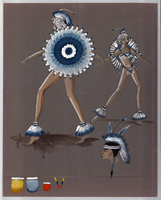
Costume design drawing, blue and white feathered Indian ensemble with headdress and cuffs, Las Vegas, 1968
Date
1968
Archival Collection
Description
Costume Details: American Indian-style costume with blue and white feathers, headdress, and shield.
Show Name: Pony Express
Site Name: Sahara Hotel and Casino
Show Name: Pony Express
Site Name: Sahara Hotel and Casino
Image
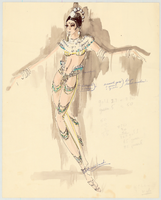
Costume design drawing, gold jeweled showgirl costume with headpiece and gold bands, circa 1965-75
Date
1965 to 1975
Archival Collection
Description
Costume Details: Female gold, turquoise, and white jeweled costume with gold arm and leg bands. Similar to Spinedi-16. Artist's notations: "4 small, 4 small, 1 large, 2 small gold, 1 pearl, 1 gold- Boy's lead nudes, gold band."
Image
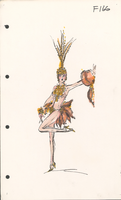
Costume design drawing, gold digger showgirl costume, Las Vegas, June 5, 1980
Date
1980-06-05
Archival Collection
Description
Bob Mackie design. Transcribed from original drawing index: "16 Bluebells (Gold diggers)."
Costume Details: Showgirl wearing a costume made of yellow and gold faux coins, with brown fur muff and gold feathered headpiece.
Show Name: Jubilee!
Performance Name: Bandwagon finale: B-Babies
Site Name: MGM Grand Hotel and Casino
Costume Details: Showgirl wearing a costume made of yellow and gold faux coins, with brown fur muff and gold feathered headpiece.
Show Name: Jubilee!
Performance Name: Bandwagon finale: B-Babies
Site Name: MGM Grand Hotel and Casino
Image

Costume design drawing, sheer blue showgirl costume with fuchsia jewels, Las Vegas, 1981
Date
1981
Archival Collection
Description
Bob Mackie design. Transcribed from original drawing index: "16 Bluebells A&B (Celestial Nights, look #1)."
Costume Details: Sheer blue showgirl costume decorated with fuchsia jewels, jeweled bra, matching headdress and cuffs.
Show Name: Jubilee!
Performance Name: Bandwagon finale: Celestial nights
Site Name: MGM Grand Hotel and Casino
Costume Details: Sheer blue showgirl costume decorated with fuchsia jewels, jeweled bra, matching headdress and cuffs.
Show Name: Jubilee!
Performance Name: Bandwagon finale: Celestial nights
Site Name: MGM Grand Hotel and Casino
Image
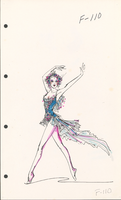
Costume design drawing, teal and fuchsia ballerina costume, Las Vegas, 1981
Date
1981
Archival Collection
Description
Bob Mackie design. Transcribed from original drawing index: Principal girl dancer (Vienna, Ballerina)."
Costume Details: Teal costume decorated with fuchsia jewels, matching sheer train, matching headdress.
Show Name: Jubilee!
Performance Name: Bandwagon finale: Vienna
Site Name: MGM Grand Hotel and Casino
Costume Details: Teal costume decorated with fuchsia jewels, matching sheer train, matching headdress.
Show Name: Jubilee!
Performance Name: Bandwagon finale: Vienna
Site Name: MGM Grand Hotel and Casino
Image
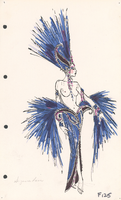
Costume design drawing, topless showgirl in blue and black feathered ensemble, Las Vegas, 1981
Date
1981
Archival Collection
Description
Bob Mackie design. Transcribed from original drawing index: "Nude showgirl (Blue #1)."
Costume Details: Topless showgirl in jeweled blue and black sheath-style skirt topped in paisley design with long blue and black feathers, large matching headdress; fuchsia accents.
Show Name: Jubilee!
Performance Name: Bandwagon finale: Stairway
Site Name: MGM Grand Hotel and Casino
Costume Details: Topless showgirl in jeweled blue and black sheath-style skirt topped in paisley design with long blue and black feathers, large matching headdress; fuchsia accents.
Show Name: Jubilee!
Performance Name: Bandwagon finale: Stairway
Site Name: MGM Grand Hotel and Casino
Image
Pagination
Refine my results
Content Type
Creator or Contributor
Subject
Archival Collection
Digital Project
Resource Type
Year
Material Type
Place
Language
Records Classification
